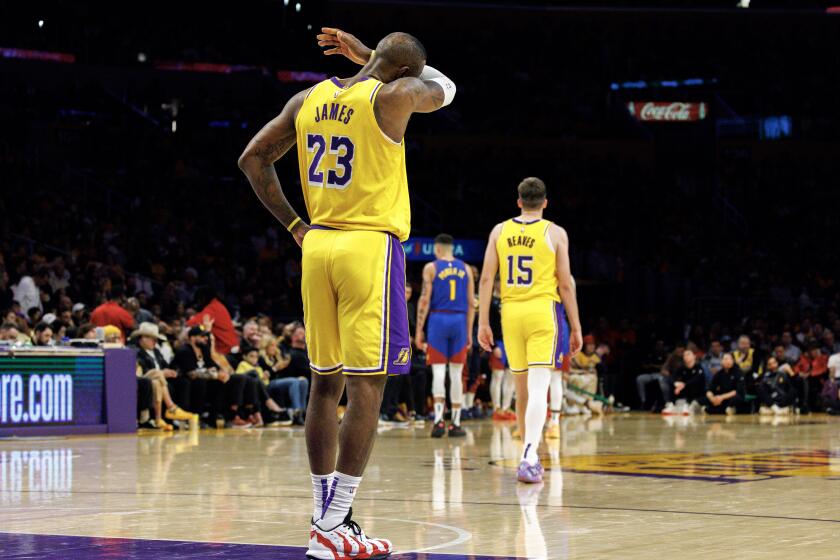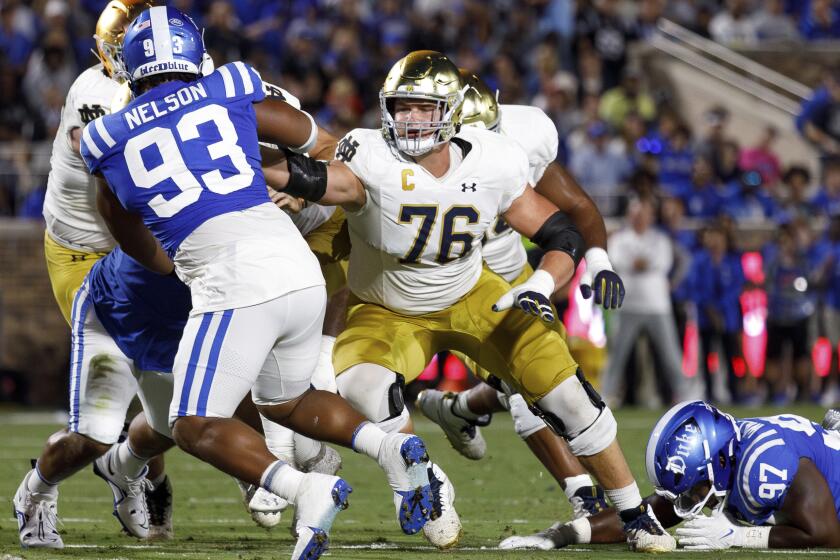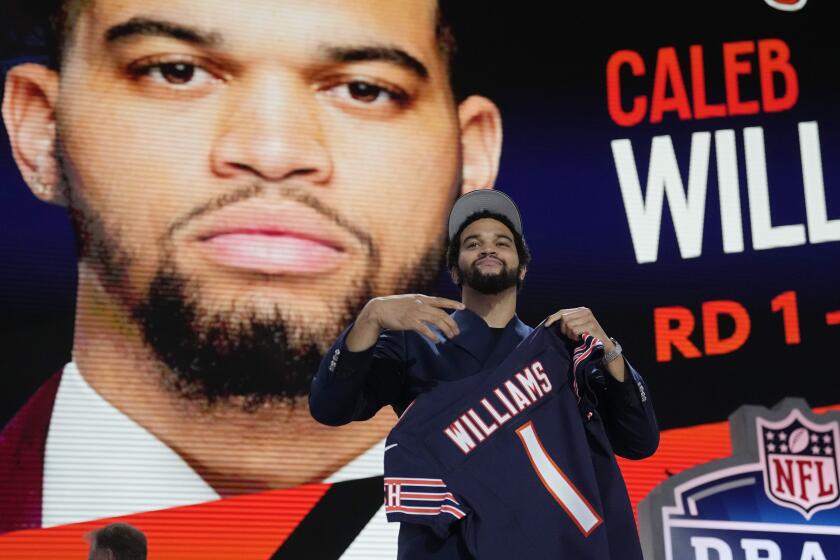Public triumph, private torment
In late April 2007, Mike Penner published an article unlike any of the thousands he had written for the Los Angeles Times. It was brief, just 823 words, and placed without fanfare on the second page of the Sports section that had been his home for 23 years.
Under the headline “Old Mike, new Christine,” Penner explained that he would soon assume a female identity and byline, a decision that followed “a million tears and hundreds of hours of soul-wrenching therapy.”
It was “heartache and unbearable discomfort” to remain a man, he explained. Being a woman promised “joy and fulfillment.” The article ended on a hopeful note: “This could be the beginning of a beautiful relationship.”
FOR THE RECORD:
Mike Penner: An article in Section A on March 27 about the late Mike Penner, the Los Angeles Times sportswriter who announced in 2007 that he was a transsexual and was adopting a female identity, quoted the sportswriter’s statement in a radio interview that he had spent nine years in a “very strict Catholic school.” In fact, Penner attended three different Catholic schools, one for seven years, according to his family. Penner committed suicide last November.—
Gone was quiet, circumspect Mike Penner, replaced by ebullient, outgoing -- and instantly famous -- Christine Daniels. Celebrity meant a megaphone, and Daniels vowed to use it as an advocate. She told her story at transsexual conferences across the country, becoming a symbol of courage to a transgender community inspired by the most visible coming-out in decades.
A year after the essay, the Daniels byline vanished from the newspaper, and within months Penner was back at work, living as a man and writing under his male name. Once so voluble about the reasons for becoming Christine, Penner was silent about the reasons for abandoning the identity.
This time, there was no essay, no explanation. But friends saw a person in torment. Last November, in the parking garage of the apartment complex where he lived alone, Penner killed himself. He was 52.
The duality that defined the sportswriter’s life divided the grieving. Mourners were split between two memorial services, one for Mike and one for Christine.
Penner was an Inglewood native who spent nine years in what he called a “very strict Catholic school.” He was an avid weekend soccer player and a lover of the punk band the Clash. He was tall and broad-shouldered, with a receding hairline and a penchant for untucked shirts.
In 1983, he jumped from the Anaheim Bulletin to The Times. Over the years, he covered high-school sports, tennis, the Angels and the NFL and developed a reputation as a wry essayist who relished global spectacles such as the Olympics and World Cup soccer.
Penner and his wife, Lisa Dillman, also a Times sportswriter, relied intensely on one another in their 20-year marriage. “It seemed to a lot of us that they were just this great love story,” said Randy Harvey, formerly the Sports editor, now an associate editor at The Times. “They just seemed to be in sync -- not necessarily with the world around them, but with each other.” The couple had no children.
It is not clear when Dillman learned about her husband’s persistent feeling that he was imprisoned in a male body, a condition known as “gender dysphoria.” In a recent column, ESPN personality Rick Reilly, who worked with Penner at The Times in the early 1980s, said his friend confided to him that he kept a dress, wig and pearls hidden in a tool box behind his bed.
By his mid-40s, Penner was regularly dressing as a woman in private and soon was venturing to transgender hangouts and attending Metropolitan Community Church, known as a gay/transgender haven. He sought counseling at the Los Angeles Gender Center.
The many friendships he built at these places were close yet compartmentalized. He could confide what he called his “most important truth,” but not his real name or where he worked. He used the name Christine, a nod to personal hero Christine Jorgensen, the transsexual who helped bring the phenomenon out of the shadows of early-1950s America.
“Christine kept telling me that she was afraid to go out in the ‘real world’ for fear of being laughed at and worse,” said Susan Horn, a transsexual who counseled Penner through the coming-out process. Horn, a Los Angeles paralegal, was in the final stages of her own transition, and the price had already been high. The attendant depression had cost her a 30-year career as a lawyer, and her teenage daughter had said, “You’re dead -- I’ll never talk to you again.”
The sportswriter accompanied Horn to Sisley, an Italian restaurant in Sherman Oaks, for dinner in August 2005, dressed as a woman. It was the first time Christine had stepped outside the sanctuary of the transgender community.
“Christine was very nervous and looking in every direction to see if anyone was looking or staring,” recalled Horn, now 61. “The waiter treated us just like he would treat any two women, and Christine was in heaven.”
After dinner, they shopped for shoes and saw “The 40-Year-Old Virgin.”
Later, Christine would recall the night with delight in an e-mail to a friend: “I know I laughed longer and harder during that movie than I would have in boy mode. To be in a favorite environment (next to music, movies are my No. 1 love) and to be yourself -- Wow!”
That evening, however, the sportswriter wept “about the prospect of having to become Mike again when she got home. It was devastating to her,” Horn said. “It became more and more difficult for her to change back.”
Still, Penner kept his dual identities secret, his selves boxed up as carefully as the wig and pearls.
Because many people afflicted with gender dysphoria don’t seek medical attention, there are no solid statistics regarding their numbers. Nor is there scientific consensus on the cause of the condition, though studies in the Netherlands point to the influence of brain anatomy.
In the past, patients with the condition felt the need to pick a male or female gender, but today younger people increasingly eschew hormones and surgery to find “an identity that’s kind of in the middle,” said Chris Kraft, a psychologist at the Sexual Behaviors Consultation Unit at Johns Hopkins medical center in Baltimore.
The path is harder for the middle-aged, because many have a rigid sense of how men and women are supposed to look. Penner told Horn and another transsexual friend, Amy LaCoe, that he wanted sex-change surgery. Before American doctors will perform the operation, they require patients to live openly for a year in their new gender to confront the difficulties and sacrifices involved without illusion or false hope.
It’s called the “real-life test,” and as he prepared for it, Penner gathered longtime friends and handed them packets about transsexualism.
He took pains, a friend recalled, to remove from the Web every picture he could find of himself as a man, consigning what he considered a counterfeit self to the past. He debated how to come out at work and worried how the publicity would affect Dillman. People who had been through the process advised a low-key approach.
At a meeting with then-Sports editor Harvey in late February 2007, Penner revealed that he would soon become Christine Daniels (his middle name was Daniel) and suggested that perhaps he should move to The Times’ Calendar section.
“I thought he felt maybe we wouldn’t accept him in Sports,” Harvey said. “I told him it was a bad idea to leave Sports. We were family to him.”
Penner wanted to become Daniels quietly, without explanation to readers. But Harvey pointed out that the name change was bound to become news. “I said, ‘I think you need to write it. Don’t let anybody else write it first,’ ” he recalled.
Penner agreed but was consumed with dread as publication day approached. He enlisted friends to monitor the e-mail feedback and sports-radio chatter.
The article, published April 26, 2007, became the paper’s most-viewed story of the year online, and the response -- from colleagues and the public -- was overwhelmingly positive. “One of the best days I’ve ever had,” the sportswriter told National Public Radio.
Two weeks later, Dillman signed papers petitioning for divorce, citing “irreconcilable differences.”
Transsexual friends -- many of whom had lost families during their transition -- recall warning Penner that maintaining the marriage was an unrealistic hope. Through a lawyer, he made overtures: Could the marriage be saved? The answer was no.
Daniels underwent electrolysis to have facial hair burned out at the root, took hormones, amassed a shoe collection and experimented with a variety of wigs: short, long, blond, brunet. She spoke in a soft, high voice, cried frequently, happy or sad. Daniels was “exuberant, dynamic, touchy, hugging, a vibrant, vivacious person,” Harvey said.
She championed transsexual rights in print and was praised at gay and transgender conferences. She chronicled her transition in a Times blog, Woman in Progress.
“Everybody wanted some of her,” said Donna Rose, a transsexual friend. “People are looking for hope.”
Autumn Sandeen, another transsexual friend, said: “A lot of people who came out around 2007 said, ‘Her courage is what made me courageous enough to come out.’ ”
A celebratory profile in the Advocate, a prominent gay publication, declared, “a heroine is born.”
Daniels said that becoming a woman had been a matter of survival. “At some point, the gender dysphoria reaches a pitch so excruciating, the transsexual will barter anything and risk everything, just to have a chance at a future, any kind of future,” she wrote in a Times review of transgender-themed films.
In the spotlight, Daniels seemed acutely self-conscious but also driven by a sense of purpose. She told people that God had given her a high profile in order to bring transsexualism into the mainstream.
“I think the prospect of what she could achieve was too attractive to turn down,” said Christina Kahrl, a transsexual who works as a sportswriter for BaseballProspectus.com. “She was daring to do more than anyone had ever tried since Christine Jorgensen.”
When British soccer superstar David Beckham arrived to play for the Los Angeles Galaxy in July 2007, Daniels joined the media fleet at Home Depot Center to greet him. It was Daniels’ first public appearance at a sports event, after 25 years of “dreaming about how it might play out if it ever came to be,” she wrote on her blog.
Journalists who had known Penner for years got their first glimpse of Daniels, who recorded the event in a droll, triumphant tone. Beckham “arrived wearing a silver-gray Burberry suit, surrounded by a phalanx of assistants and yes-people,” she wrote on her blog. “I arrived wearing a golden-hued top from Ross and a multicolored paisley skirt from Ames and a pair of open-toed tan heels from Aerosoles, surrounded by nobody. . . . “
Paul Oberjuerge, then a sports columnist for the San Bernardino Sun, was in the crowd. “I hate to be judgmental about these things, but Christine is not an attractive woman,” he wrote on his blog, noting that Daniels had a prominent Adam’s apple and stood more than 6 feet tall in wobbly heels. “It seemed almost as if we’re all going along with someone’s dress-up role playing. . . . “
Daniels was wounded by such criticism -- and by comments from other transsexuals who faulted her for an excessive interest in dresses, jewelry and other outward trappings of femininity.
As the year wore on, Daniels grew estranged from the Los Angeles transsexual community, complaining that she had become a fundraising tool. At one gathering, she spoke of how supportive the Los Angeles Times had been, only to be confronted by someone who insisted that this didn’t reflect the experience of most transsexuals.
“She didn’t know who to trust in the community,” Sandeen said, “because all these people were willing to use her.”
In October 2007, Daniels showed up at a Los Angeles studio to pose for photographs to accompany a profile in Vanity Fair magazine. The photographer, Robert Maxwell, said Daniels wore simple, elegant dresses in what was intended as a “conservative, classy-type look.”
Maxwell said he sensed Daniels’ brittleness and tried to deal with her sensitively. On seeing the photos, she dissolved into tears, saying: “I’m ugly.”
“I told her, ‘No, you’re beautiful,’ ” Maxwell said. “I was trying to say all the right things. How do you tell someone who looks like a man, ‘You’re a beautiful woman’? I don’t know.” As he tried to console her, Maxwell recalled, she pushed him away. The photo shoot was “a total debacle, probably the worst experience of my transition,” Daniels wrote in an e-mail to a friend.
The photographer “apparently wanted to portray me as a man in a dress -- my worst fear,” Daniels wrote. “I felt betrayed, totally abused, and very very vulnerable and exposed and alone in the world.”
The profile writer, Evan Wright, said that to write an honest article, he would have to observe that the sportswriter did not pass as a woman. “I thought, ‘Bottom line, she has a fantasy conception. She doesn’t accept who she is.’ ”
Wright said that after the photo shoot, he was so afraid Daniels would commit suicide that he asked his editor to cancel the story. It was never written.
The episode seemed to mark a turning point, a retreat. By year’s end, Daniels had cut off many of her transsexual friends.
She let weeks pass without updating Woman in Progress. In February 2008, Tony Pierce, The Times’ blogs editor, asked Daniels whether she wanted to stop the blog.
“She said she didn’t want to be the spokesperson for anything, but unfortunately that’s what she had become,” Pierce said. Posts remained infrequent, and Daniels eventually asked to have the blog discontinued.
One transgender friend, Sara Hayward, heard an eerie shifting in Daniels’ speech during a conversation in early March. Now and then, Daniels’ soft, steady voice would give way abruptly to Penner’s voice, deep and cracking. “It was two voices coming out of the same person,” Hayward said.
Daniels, who had been writing a sports-media column called Sound and Vision, had her last byline in The Times on April 4, 2008, then went on extended disability leave. She was despondent -- close friends knew she was manic depressive -- failing to eat and stricken with esophageal pain.
Daniels told Amy LaCoe, her transsexual friend, that she had ruined her marriage and made a mess of her life. LaCoe insisted that Daniels stay with her for a couple months. “She stared at my bedroom ceiling for a long time,” LaCoe said. “She had stopped caring about herself.”
Daniels stopped taking hormones and began getting rid of the physical trappings of Christine, LaCoe said, giving the jewelry and shoe collection to friends, donating the wigs, carting the clothes to Goodwill. In a matter of months, the whole identity had been banished.
Just as Penner had once hunted down and removed his male pictures from the Web, he now sought to erase evidence that Christine Daniels had ever existed. He asked editors to have archives of the Woman in Progress blog erased. They refused, citing the paper’s policy of preserving its records.
Nevertheless, at some point the archives vanished. Pierce said he has been unable to retrieve the posts or determine who deleted them.
When the sportswriter returned to work as Mike Penner in late October 2008, co-workers noticed that his manner was remote, his handshake unsteady. His face was changed, the jaw line permanently smooth from electrolysis. He did not want to talk about his experience, much less write about it.
When a transsexual friend asked what had happened, Penner responded, “Well, that’s why there’s a real-life test.” Friends said he held out hopes of saving his marriage, but by year’s end, his divorce was finalized.
In the summer of 2009, Horn and LaCoe said, he was hospitalized for a psychiatric evaluation.Horn said that a delusional Penner called her from the hospital, accusing The Times of having broken into his apartment to steal compromising pictures.
On Nov. 25, over dinner with LaCoe at Marie Callender’s, Penner was deeply depressed and indifferent to advice. “He didn’t want to hear my mouth,” she said. “Maybe he felt something was settled.”
Penner had been renting a one-bedroom apartment at the Westwood Villa Apartments on Sepulveda Boulevard, a big, bedraggled, anonymous complex.
About 5:45 p.m. on Nov. 27, Penner entered the apartment office to deposit two envelopes in the outbox -- payments to Verizon and a credit card company. Three hours later, neighbors found him slumped in the front seat of his 1997 Toyota Camry in the underground parking garage. The windows were fogged, and a vacuum hose stretched from the exhaust into the passenger window.
The silence that enveloped Penner’s last months now extends among almost all the journalists who knew him best at The Times, including his ex-wife, who covers the Clippers, and his brother John, who works on the copy desk. Neither responded to requests to be interviewed for this article.
At the family memorial service at Forest Lawn in Cypress, mourners were screened to keep out reporters who might write about it.
A second memorial service, open to anyone, was held weeks later at Metropolitan Community Church Los Angeles. The pastor made it clear, as did the picture on the program, that they were saying goodbye not to Mike Penner but to Christine Daniels.
Horn stepped onstage and told a personal story. When she came out as a transsexual, her teenage daughter had shunned her. After “Old Mike, new Christine” was published, her daughter called. She had read the article. She understood now.
“Christine did that for me,” Horn said. “She did that for all of us.”
christopher.goffard@latimes.com
More to Read
Get our high school sports newsletter
Prep Rally is devoted to the SoCal high school sports experience, bringing you scores, stories and a behind-the-scenes look at what makes prep sports so popular.
You may occasionally receive promotional content from the Los Angeles Times.







